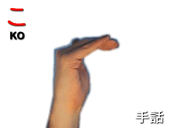Ko (kana)
こ, in hiragana or コ in katakana, is one of the Japanese kana, each of which represents one mora. Both represent IPA: [ko]. The shape of these kana comes from the kanji 己.
| ko | ||||
|---|---|---|---|---|
| ||||
| transliteration | ko | |||
| translit. with dakuten | go | |||
| translit. with handakuten | (ngo) | |||
| hiragana origin | 己 | |||
| katakana origin | 己 | |||
| spelling kana | 子供のコ (Kodomo no "ko") | |||
| kana gojūon | ||||||||||||||||||||||||||||||||||||||||||||||||||
|---|---|---|---|---|---|---|---|---|---|---|---|---|---|---|---|---|---|---|---|---|---|---|---|---|---|---|---|---|---|---|---|---|---|---|---|---|---|---|---|---|---|---|---|---|---|---|---|---|---|---|
|
||||||||||||||||||||||||||||||||||||||||||||||||||
This character may be supplemented by a dakuten; it becomes ご in hiragana, ゴ in katakana and go in Hepburn romanization. Also, the pronunciation is affected, transforming into [ɡo] in initial positions and varying between [ŋo] and [ɣo] in the middle of words.
A handakuten (゜) does not occur with ko in normal Japanese text, but it may be used by linguists to indicate a nasal pronunciation [ŋo].
| Form | Rōmaji | Hiragana | Katakana |
|---|---|---|---|
| Normal k- (か行 ka-gyō) |
ko | こ | コ |
| kou koo kō |
こう こお こー |
コウ コオ コー | |
| Addition dakuten g- (が行 ga-gyō) |
go | ご | ゴ |
| gou goo gō |
ごう ごお ごー |
ゴウ ゴオ ゴー |
Stroke order
 Stroke order in writing こ |
 Stroke order in writing コ |

Stroke order in writing こ

Stroke order in writing コ
Other communicative representations
| Japanese radiotelephony alphabet | Wabun Code |
| 子供のコ Kodomo no "Ko" |
|
|
 |
 | |
| Japanese Navy Signal Flag | Japanese semaphore | Japanese manual syllabary (fingerspelling) | Braille dots-246 Japanese Braille |
- Full Braille representation
| こ / コ in Japanese Braille | |||||||
|---|---|---|---|---|---|---|---|
| こ / コ ko | ご / ゴ go | こう / コー kō/kou | ごう / ゴー gō/gou | Other kana based on Braille こ | |||
| きょ / キョ kyo | ぎょ / ギョ gyo | きょう / キョー kyō/kyou | ぎょう / ギョー gyō/gyou | ||||
| Character | こ | コ | コ | ご | ゴ | |||||
|---|---|---|---|---|---|---|---|---|---|---|
| Unicode name | HIRAGANA LETTER KO | KATAKANA LETTER KO | HALFWIDTH KATAKANA LETTER KO | HIRAGANA LETTER GO | KATAKANA LETTER GO | |||||
| Encodings | decimal | hex | decimal | hex | decimal | hex | decimal | hex | decimal | hex |
| Unicode | 12371 | U+3053 | 12467 | U+30B3 | 65402 | U+FF7A | 12372 | U+3054 | 12468 | U+30B4 |
| UTF-8 | 227 129 147 | E3 81 93 | 227 130 179 | E3 82 B3 | 239 189 186 | EF BD BA | 227 129 148 | E3 81 94 | 227 130 180 | E3 82 B4 |
| Numeric character reference | こ | こ | コ | コ | コ | コ | ご | ご | ゴ | ゴ |
| Shift JIS | 130 177 | 82 B1 | 131 82 | 83 52 | 186 | BA | 130 178 | 82 B2 | 131 83 | 83 53 |
This article is issued from Wikipedia. The text is licensed under Creative Commons - Attribution - Sharealike. Additional terms may apply for the media files.

